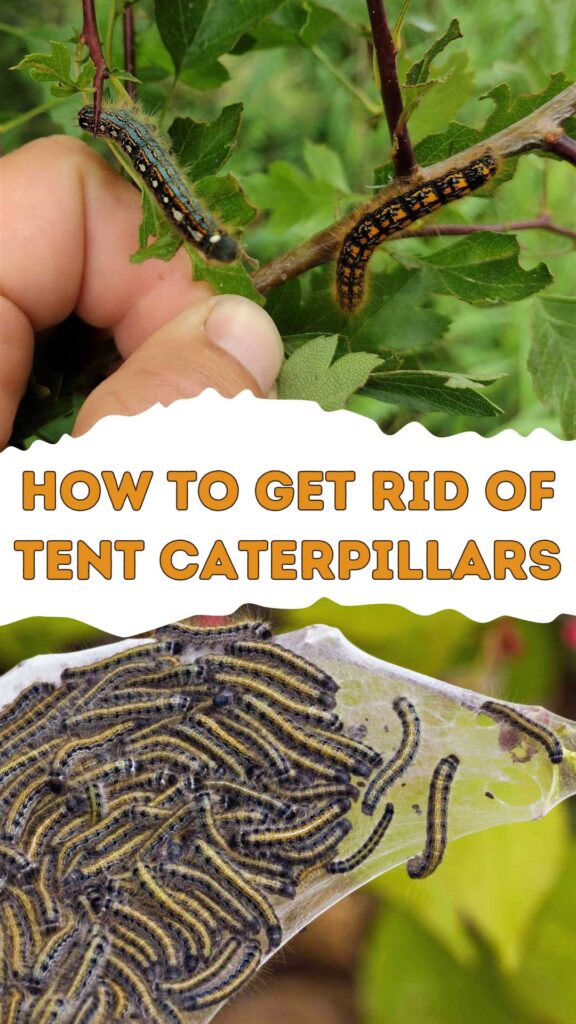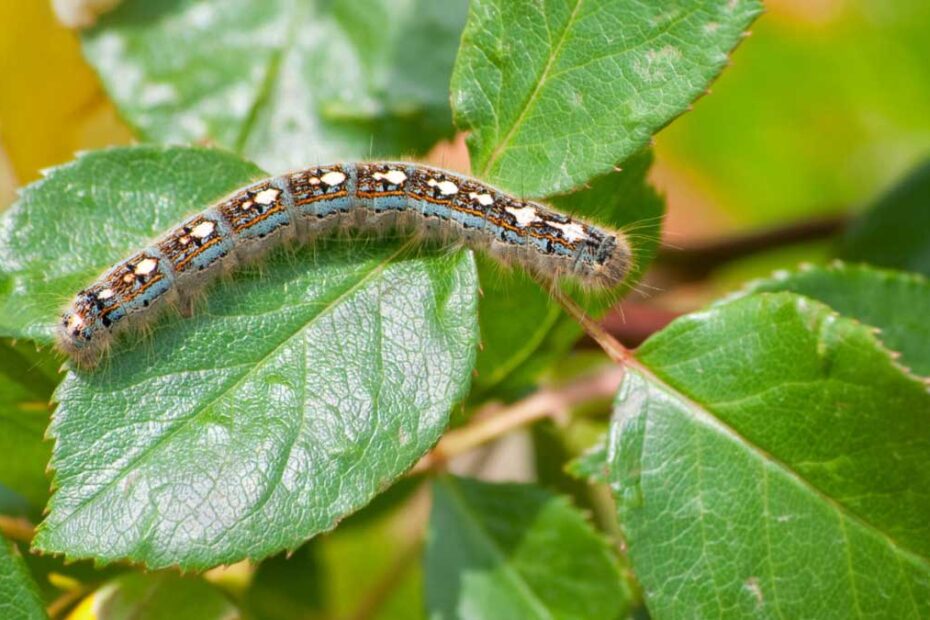Are tent caterpillars turning your beautiful garden into a nightmare? These pesky insects can defoliate trees and shrubs, leaving your world looking barren and unhealthy. Fortunately, you can take effective steps to reclaim your garden and keep it thriving.
Key Takeaways
- Proper Identification: Understanding the different species of tent caterpillars, including Eastern, Forest, and Western types, helps in accurate identification and effective management of infestations.
- Lifecycle Knowledge: Recognizing the stages of tent caterpillar development (egg, larval, pupal, adult) is crucial for timely intervention and control.
- Natural Remedies: Employing eco-friendly solutions, such as manual removal, biological controls like Bacillus thuringiensis (Bt), and encouraging natural predators, can effectively reduce caterpillar populations.
- Chemical Solutions: Utilizing insecticides and understanding their application and associated precautions can help manage severe infestations while minimizing risks to plants and beneficial insects.
- Preventive Measures: Regular tree inspections and proper maintenance, including pruning, fertilizing, deep watering, and mulching, can prevent infestations and ensure plant health and resilience.

Understanding Tent Caterpillars
Tent caterpillars belong to the genus Malacosoma and are known for their communal habit of spinning silk tents in the branches of host trees. While they don’t pose a significant health risk to humans or animals, they can cause extensive damage to various trees and shrubs.
Key Species
- Eastern Tent Caterpillar (Malacosoma americanum): Primarily targets wild cherry, apple, and crabapple trees. Identified by its black body with a white stripe down the back.
- Forest Tent Caterpillar (Malacosoma disstria): Prefers oak, maple, and aspen trees. Features a blue body with white keyhole-shaped spots.
- Western Tent Caterpillar (Malacosoma californicum): Feeds on alder, willow, and fruit trees. Recognizable by its orange body with blue and black markings.
- Egg Stage: Eggs are laid in a mass encircling small twigs, where they overwinter. Egg masses appear dark gray and are glossy.
- Larval Stage: Emerging in spring, larvae immediately start feeding and constructing their tents. The larval stage lasts 4-6 weeks.
- Pupal Stage: Caterpillars pupate in cocoons either on the tree or nearby structures. This phase lasts 10-14 days.
- Adult Stage: Moths emerge from cocoons, mate, and lay eggs to complete the cycle. Adult moths live for a few days.
Habitats
These pests favor deciduous trees and shrubs. Common habitats include:
- Forest edges
- Orchards
- Woodland areas
- Urban parks
Understanding tent caterpillars can help you identify and manage their presence more effectively. Examine your garden regularly to spot early signs, like silk tents in the branches. Use timely intervention methods to mitigate their negative impact.
Identifying Tent Caterpillar Infestations
Recognizing a tent caterpillar infestation early is crucial for mitigating damage to your garden. Identifying these pests involves observing key signs and symptoms and knowing the common species involved.
Signs and Symptoms
Look for the following indicators when checking for tent caterpillar infestations:
- Silken Tents: Spot large, silken tents in the forks of tree branches. These tents serve as shelters for caterpillars.
- Defoliation: Check for missing or skeletonized leaves, which indicate feeding activity.
- Caterpillar Trails: Notice any trails of caterpillars moving to and from the tent for feeding.
- Egg Masses: Examine tree branches for egg masses that appear as shiny, black, or brown bands encircling the branches in early seasons.
- Frass: Identify the presence of frass (caterpillar droppings) beneath infested trees, often greenish or brownish.
Common Species
Three main species of tent caterpillars may infest your garden:
- Eastern Tent Caterpillar (Malacosoma americanum): Prefers cherry, apple, and crabapple trees. Distinguished by a solid white stripe down its back.
- Forest Tent Caterpillar (Malacosoma disstria): Targets oaks, maples, and other hardwoods. Characterized by a row of keyhole-shaped spots.
- Western Tent Caterpillar (Malacosoma californicum): Infests various fruit trees and ornamental shrubs. Identified by blue and orange stripes along its body.
Identifying tent caterpillar infestations involves understanding their signs and recognizing the specific species. Early detection allows for more effective control and helps protect your garden’s health and appearance.
Natural Remedies To Eliminate Tent Caterpillars
Natural remedies provide eco-friendly options to combat tent caterpillars without harming other wildlife or plants. These methods include manual removal techniques and biological controls.
Manual Removal Techniques
Manual removal involves physically taking caterpillars or their nests from infested trees or bushes. It’s best to do this early in the morning or late evening when caterpillars are less active.
- Handpicking: Wear gloves and collect caterpillars directly from the branches.
- Pruning: Cut off branches that contain nests, placing them immediately into a bucket of soapy water.
- Disposal: After removing nests, be sure to dispose of them far from your garden to prevent re-infestation.
Biological Controls
Biological controls use natural predators and microorganisms to manage caterpillar populations. These methods help maintain the garden’s ecological balance.
- Bacillus thuringiensis (Bt): A bacteria that kills caterpillars when ingested. Apply Bt spray directly to foliage.
- Natural Predators: Introduce or attract birds, such as chickadees and robins, which feed on tent caterpillars. You can install bird feeders to maintain their presence.
- Parasitic Wasps: These wasps lay eggs inside caterpillar bodies, eventually killing them. Garden centers may sell these beneficial insects.
For effective use, apply these remedies consistently and monitor your garden regularly. This reduces caterpillar numbers while safeguarding plant health.
Chemical Solutions For Tent Caterpillars
Chemical solutions provide an efficient way to deal with tent caterpillars when infestations become severe. These methods work quickly, but it’s crucial to understand how to apply them correctly to protect your plants.
Insecticides
Insecticides are potent chemical substances formulated to kill or repel pests.
Types of Insecticides:
- Contact Insecticides: Kill caterpillars upon direct contact. Example: Permethrin
- Systemic Insecticides: Absorbed by plants, targeting pests that feed on them. Example: Imidacloprid
- Insect Growth Regulators (IGRs): Interfere with caterpillar development. Example: Methoprene
Easy-to-apply sprays and dusts make insecticides user-friendly. For best results, cover all infested areas.
Usage Precautions
While effective, insecticides carry risks if not used properly. Follow these precautions to avoid harmful effects on your garden and health:
- Read Labels: Understand specific instructions and safety measures.
- Wear Protection: Gloves, masks, and protective clothing are essential.
- Apply at the Right Time: Early morning or late evening reduces impact on beneficial insects.
- Avoid Overuse: Excessive application can damage plants and disrupt ecosystems.
- Store Properly: Keep insecticides in original containers, away from children and pets.
Consistent and mindful application ensures chemical solutions effectively manage tent caterpillar infestations without causing unintended harm.
Preventive Measures
Implementing preventive measures against tent caterpillars is essential to protect your garden from potential infestations. Regular inspections and proper tree maintenance are key activities to ensure your plants stay healthy and robust.
Regular Tree Inspections
Frequent inspections help catch early signs of tent caterpillar infestations. These checks allow for prompt action, limiting damage.
Inspection Steps:
- Check for Egg Masses: Look for oval, brownish-gray clusters wrapped around branches, especially during winter.
- Search for Silken Tents: Spot silken nests in tree branches, mostly seen in early spring.
- Monitor Defoliation: Examine leaf loss, which can signal the presence of caterpillars.
- Identify Frass: Look for black droppings below trees, indicating caterpillar activity.
Consistency in these inspections aids in early detection and management of infestations.
Tree Maintenance Tips
Proper tree maintenance fortifies your trees against tent caterpillars. Healthy trees are less likely to suffer severe damage.
- Prune Regularly: Remove dead or infested branches to reduce caterpillar habitats.
- Fertilize Adequately: Provide essential nutrients to strengthen trees.
- Water Deeply: Ensure deep-root watering during dry periods to sustain tree health.
- Apply Mulch: Use mulch around tree bases to retain moisture and improve soil quality.
Following these tree maintenance practices creates a robust and hostile environment for tent caterpillars, safeguarding your garden from infestations efficiently while maintaining a healthy world.
Conclusion
Dealing with tent caterpillars can be challenging, but with the right approach, you can protect your garden from these pests. Early identification and regular inspections are crucial for effective management. By utilizing natural remedies and biological controls, you can address infestations without harming the environment.
In cases of severe infestations, chemical solutions can be effective if used properly. Always follow guidelines to ensure the safety of your plants and the surrounding ecosystem. Preventive measures like proper tree maintenance and consistent monitoring will help keep your garden healthy and caterpillar-free. With dedication and the right strategies, you can safeguard your garden and enjoy its beauty all season long.
Frequently Asked Questions
What are tent caterpillars?
Tent caterpillars are pests that defoliate trees and shrubs, affecting garden health and appearance. They create silky tents in tree branches and can significantly harm trees if not managed.
Which species of tent caterpillars are most common?
Common species include the Eastern Tent Caterpillar, Forest Tent Caterpillar, and Western Tent Caterpillar. Each species targets different types of trees.
How can I identify a tent caterpillar infestation?
Look for signs like silken tents in tree branches, defoliation, caterpillar trails, egg masses, and frass (caterpillar droppings).
Which trees are most affected by tent caterpillars?
Cherry and apple trees commonly attract Eastern Tent Caterpillars, while oaks and maples are targeted by Forest Tent Caterpillars. Western Tent Caterpillars infest various fruit trees.
What are some natural remedies to eliminate tent caterpillars?
Handpicking caterpillars, pruning infested branches, using natural predators like birds or parasitic wasps, and applying Bacillus thuringiensis (Bt) are effective natural remedies.
Are chemical solutions necessary for severe infestations?
For severe infestations, insecticides like contact insecticides, systemic insecticides, and insect growth regulators (IGRs) can be efficient. Proper application is critical to minimize garden harm.
How should insecticides be applied safely?
Read labels, wear protective gear, apply at optimal times, avoid overuse, and store insecticides properly to ensure safe application.
What preventive measures can protect my garden from infestations?
Conduct regular inspections, maintain proper tree care such as pruning, fertilizing, deep watering, and mulching to create a robust environment that deters tent caterpillar infestations.
Why is early detection important in managing tent caterpillars?
Early detection allows for timely intervention, reducing the extent of the damage and making it easier to manage the infestation effectively.
Can tent caterpillars be controlled without harming other wildlife?
Yes, using natural remedies like biological controls, manual removal, and eco-friendly products ensures the reduction of caterpillar populations without harming other wildlife.
